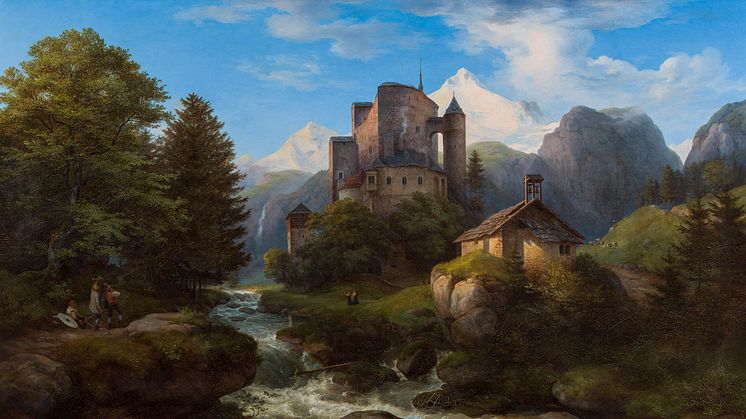
Press release -
Oehme landscape acquired by Nationalmuseum
Nationalmuseum has acquired a painting by the German artist Ernst Ferdinand Oehme. Tyrolean Landscape with Naudersberg Castle, dating from 1847, represents an aspect of German Romanticism that was previously absent in the museum’s collection. Opportunities to acquire paintings of this kind made by Oehme are very rare.
The newly acquired painting by Ernst Ferdinand Oehme (1797–1855), dated 1847, depicts Naudersberg castle surrounded by Tyrolean mountain scenery. Such paintings are very rare, one reason being that Oehme’s oeuvre is relatively small. His works are technically complex and were therefore time-consuming to produce. Another reason for their rarity is that several of the paintings were lost in war, while the majority of those that survived are now in German museum collections.
Oehme was a close associate and pupil of Caspar David Friedrich, now the best-known of the German Romantic painters. Although close to the influential Friedrich, Oehme created an aesthetic that was unmistakably his own. His paintings can be described as somewhat more dreamlike, with a nod to the world of fairytales. Some of the German Romantics, Oehme among them, adopted and revived the ancient notion of a world soul: the idea of an all-pervasive spirit (nowadays we would probably rather call it an energy) that creates a cycle transcending all the boundaries of time and space. Oehme frequently portrayed old fortified castles and medieval figures in sharply naturalistic landscapes resembling the scenery familiar to his contemporary audience. This was his way of bridging the divide between the ages and creating a sense of connection with the people who went before.
With its realistic and yet enigmatic atmosphere, this painting represents an art that appealed more to the subjective imagination than to rational thinking. A river runs through its centre. On one side of the river, we see a group of armed men calling out to two women on the opposite bank. The landscape is faithfully rendered, down to the smallest detail, and yet in colours that make nature appear almost supernatural. Thus Oehme’s painting is a good example of how the Romantics sought to ‘alienate’ nature: to make the viewer stop and reflect on things that ‘are just there’.
“This newly acquired Oehme painting helps us explain to our visitors why one of the truly revolutionary periods in art history was indeed revolutionary,” said Carl-Johan Olsson, curator 19th century art at Nationalmuseum. “In the Romantic period, not only the fundamentals of visual art changed, but also the way of looking at it. Suddenly, it was no longer about trying to read and understand images, but much more about the experience of being triggered by images that attract us without immediately letting us know why. In many ways, this is basically how we interpret the world around us, and images of it, even today.”
Nationalmuseum receives no state funds with which to acquire design, applied art and artwork; instead the collections are enriched through donations and gifts from private foundations and trusts. The acquisition was a generous gift from the Friends of Nationalmuseum.
Inventory number
Ernst Ferdinand Oehme: Tyrolean Landscape with Naudersberg Castle, 1847. Oil on canvas. NM 7632.
Media enquiries
Carl-Johan Olsson, curator: carl-johan.olsson@nationalmuseum.se, +46 8 5195 4324
Hanna Tottmar, head of press: press@nationalmuseum.se, +46 8 5195 4400
Categories
Nationalmuseum is Sweden’s museum of art and design. The collections comprise some 700 000 objects, including paintings, sculpture, drawings and graphic art from the 16th century up to the beginning of the 20th century and the collection of applied art and design up to the present day. Nationalmuseum’s responsibility is to preserve and make art accessible and provide knowledge.

